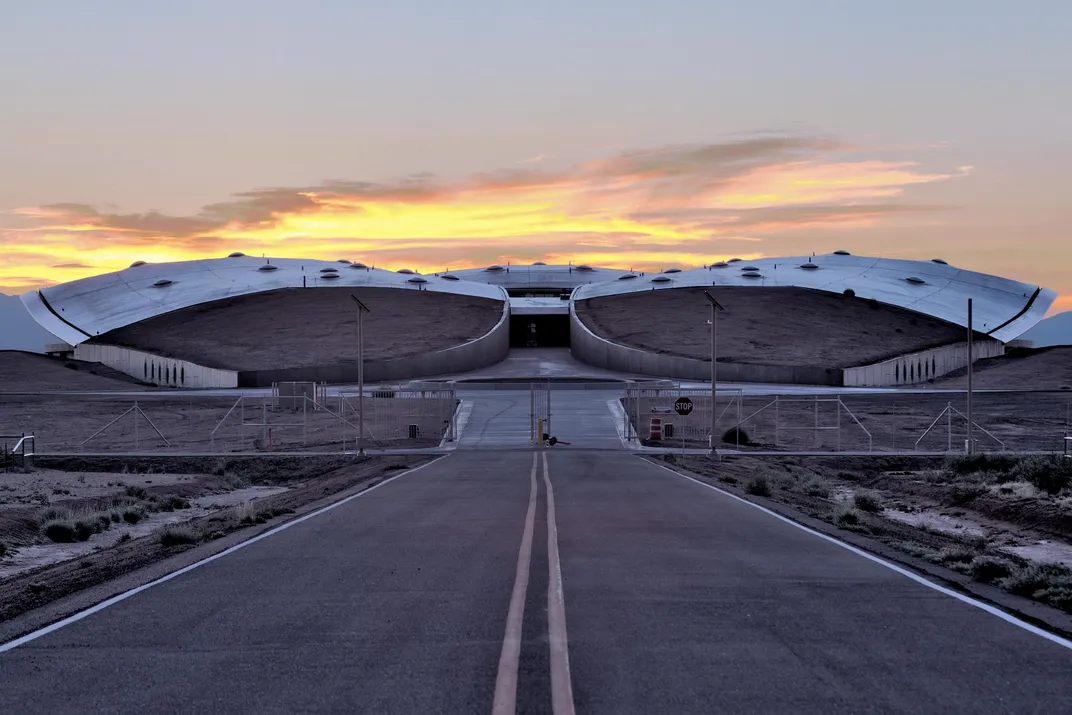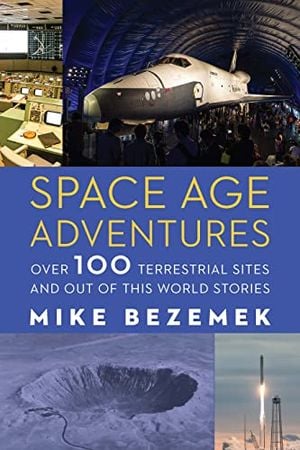Seven Ways to Explore Space Without Leaving Earth
From astronaut training sites to working spaceports, these spots across the United States put a terrestrial spin on space travel
:focal(1061x707:1062x708)/https://tf-cmsv2-smithsonianmag-media.s3.amazonaws.com/filer_public/d8/3d/d83dcccc-1047-4214-9af3-82d992c13625/gettyimages-869027136.jpg)
On a warm June evening several years ago, after 17 days rowing whitewater through the Grand Canyon, I was too tired to drive back to my summer base near Moab. I was searching for a quick campsite and found one amid the strangest of worlds: Cinder Hills Off Highway Vehicle Area in northern Arizona.
Filled with cinder cones and craters, the area looked like it had been hit by both a volcanic eruption and a meteor strike. As it turns out, the Cinder Hills were bombarded in the 1960s—not by natural forces but by some adventurous specialists from the United States Geological Survey and NASA. They were recreating a portion of the moon’s Sea of Tranquility, the smooth terrain where Apollo 11 would land in 1969.
When I was a kid, I was fascinated by space exploration. I devoured issues of Air & Space magazine, space books and science fiction shows. Yet, like a lot of enthusiasts, I found the 1990s and 2000s to be hard times. The plodding pace of real-life human space exploration caused my enthusiasm to wane. I became a raft guide and travel writer focused on Earthly adventures. But from dark-sky campsites across the country, I kept looking up at night, wondering when that next step beyond low Earth orbit might happen.
Stumbling across the Cinder Hills astronaut training site just when new NASA missions and SpaceX rockets were starting to launch stoked my interest in rediscovering the space age. Already I’d stopped by many space-related sites over the years, but how many more were out there? After a multiyear mission with plenty of research and travel, I was pleasantly surprised, finding more than 100 spots across the U.S. These places, captured in my new book Space Age Adventures: Over 100 Terrestrial Sites and Out of this World Stories, include astronaut training sites, artifact-filled museums, mountaintop observatories, working spaceports and NASA centers.
We’ve finally arrived at the dawn of a second space race. Public-private partnerships will carry humans back to the moon, onward to Mars and hopefully beyond. If you count yourself a casual enthusiast, having your own space-related fun down here might be an exciting way to connect more deeply with the events unfolding up there. Here are seven adventures to get you started.
Have your own extravehicular activity at Arizona’s Bonito lava flow
/https://tf-cmsv2-smithsonianmag-media.s3.amazonaws.com/filer_public/df/c2/dfc24043-b6ac-488a-ac31-c1f759769a26/gettyimages-667277598.jpg)
Just up the road from the Cinder Hills is Sunset Crater Volcano National Monument, another astronaut training site. In the early 1970s, commander Gene Cernan and geologist Jack Schmitt trained here before Apollo 17. The mission for this final lunar landing was to find evidence of volcanism on the moon. The two astronauts used the jagged Bonito lava flow, along with surrounding cinder fields and cones, to test equipment and practice geological survey techniques.
In December 1972, Cernan and Schmitt landed in a valley of the Taurus mountain range in the Sea of Serenity. Satellite imagery had suggested these lunar highlands might be volcanic in nature. The pair’s first extravehicular activity—as astronauts call such trips outside their spacecraft—turned up mostly breccias, conglomerate rocks created by the meteorite impacts that actually formed most lunar mountains. But halfway through their second excursion, Schmitt became ecstatic when he spotted something unusual: orange soil. Analysis back on Earth proved the mission a success. They had found remnants of volcanic glass. The eventual theory was that billions of years ago, the moon was a magmatically turbulent place, where lava explosively burst from the low-gravity surface to great heights before raining down as tiny grains of orange glass.
Today, the 3,138-acre Sunset Crater Volcano National Monument offers an excellent way to experience the Arizona landscape that once simulated the lunar environment. A series of short trails allow you to explore some of the volcanic processes that Artemis astronauts may search for when they return to the moon in coming years.
View Earth’s best-preserved meteor impact crater in Arizona
/https://tf-cmsv2-smithsonianmag-media.s3.amazonaws.com/filer_public/cb/a0/cba0c649-0992-4658-9498-cd55e125c1b3/gettyimages-519985082.jpg)
Fifty thousand years ago, an iron-nickel meteor about 150 feet across plummeted through the atmosphere at around 26,000 miles per hour. When it impacted present-day Arizona, it excavated a crater three-quarters of a mile wide and 700 feet deep. Today, Meteor Crater is the best-preserved and most-studied impact feature on Earth.
Aerial photos of the site might easily be mistaken for the lunar surface, which is why members of the Apollo Program visited in the 1960s. With scientists leading the way, astronauts scrambled around the crater floor, slopes and rim. Their mission was to understand ejecta patterns—the blasted material that lands outside the crater—and help astronauts develop an understanding of how to sample this material while on the moon.
Today, the fascinating indoor-outdoor Barringer Space Museum is perched on the rim of the crater. Outside, you can visit several viewpoints or continue walking along the rim with a guided tour, included with admission ($27 for adults and teens). Inside, you can learn about the crater’s origin and meteor impacts around the world. Plus, you can view up close the Holsinger Meteorite, the biggest fragment recovered from the larger impactor that excavated the crater.
Board a spacecraft recovery vessel in New York City
/https://tf-cmsv2-smithsonianmag-media.s3.amazonaws.com/filer_public/a6/c3/a6c3c382-a63b-4067-acb1-b72fc38ab565/gettyimages-1405845833.jpg)
Docked in the Hudson River alongside Pier 86, the retired aircraft carrier USS Intrepid is the centerpiece of the Intrepid Sea, Air and Space Museum. In addition to tours of duty during World War II and the Vietnam War, the Intrepid also served as a spacecraft recovery vessel for the two human spaceflight projects before Apollo. Project Mercury’s goal was to put an American in orbit. Project Gemini was all about learning to fly in space, so the U.S. could land the first astronauts on the moon and return them safely to Earth.
While NASA experimented with returning the capsules over land, the safer choice was deemed to be landing in the ocean. The Navy decided an aircraft carrier group had the needed capabilities for retrieval, including the radar equipment to spot the capsules and the helicopters to hoist them from the water to the ship. But the maneuver was quite challenging, and the second Project Mercury suborbital flight, nicknamed Liberty Bell 7, ended with the capsule sinking into the sea. Astronaut Gus Grissom flung himself out the hatch and nearly drowned, as his spacesuit filled with water, before the helicopter crew lifted him to safety. Afterward, the water-based retrieval training by naval personnel and astronauts intensified.
Headlining the space artifacts at the Intrepid Museum is the Space Shuttle Enterprise. This test orbiter—for NASA’s fourth human spaceflight program—was flown in the atmosphere to practice techniques for landing on an airstrip. And yes, the familiar name was in reference to the beloved TV show “Star Trek,” the result of a late-1970s letter-writing campaign from thousands of fans.
Tour an active spaceport in New Mexico

In May 2021, New Mexico became the third state in the U.S., after Florida and California, to send people into space. New Mexico’s Spaceport America traces its roots to the Ansari X Prize, a late-1990s contest with a $10 million award for the first private company to launch a reusable crewed vehicle into space twice in two weeks. For eight years, 26 teams from around the world competed. Burt Rutan won with his experimental spaceplane SpaceShipOne, which flew twice in the fall of 2004, from California’s Mojave Desert to an altitude over 60 miles high.
Six years later, the company Scaled Composites began testing SpaceShipTwo, an improved version twice the size of the original. The goal was to offer commercial space-tourism flights in partnership with billionaire Richard Branson’s endeavor Virgin Galactic. During a 2014 test flight, a mishap caused the spaceplane to break apart, leading to the first astronaut fatality during a crewed commercial spaceflight.
But in 2021, Branson was among the passengers for the first commercial spaceflight in history, which launched and landed from SpaceShipTwo’s new home: Spaceport America in New Mexico. Today, visitors can join a popular guided tour, which often books up months in advance, originating from the Spaceport America Visitor Center in the nearby town of Truth or Consequences. Depending on what’s happening at the spaceport, the tour typically visits the operations center, fire station, runway and hangar, where Virgin Galactic spaceplanes may be visible.
See a spacecraft being built in Pittsburgh
/https://tf-cmsv2-smithsonianmag-media.s3.amazonaws.com/filer_public/14/7c/147c15b7-5283-4ee1-9870-219aa86b7fa8/52429893803_93097f2057_h.jpg)
In late 2022, the experience-based Moonshot Museum opened in Pittsburgh. The museum’s focus is on current and future space missions, including NASA’s return to the moon with the Artemis program. One unique twist is that the museum shares a building with Astrobotic Technology, and a wall of windows allows you a close view into the aerospace company’s workshop, where lunar landers and rovers are built.
From just a few feet away, you might see technicians and engineers building and testing robotic spacecraft related to Astrobotic’s supporting role in the Artemis missions. One current effort is the company’s Griffin lander, which will deposit the Artemis rover Viper on the lunar surface to search for frozen water. Robotic sidekicks such as these, when compared to past programs like Apollo, will play a vastly expanded role in upcoming human explorations beyond low Earth orbit. They might scout for landing sites or set up infrastructure for a lunar base.
The creators of the Moonshot Museum hope that this unprecedented view inside a working clean room will inspire renewed interest in space exploration. Perhaps young visitors will one day embark on their own careers in the space industry.
Watch a rocket launch in Virginia
/https://tf-cmsv2-smithsonianmag-media.s3.amazonaws.com/filer_public/3a/c5/3ac58e13-f8de-4843-9518-f3bc51079632/gettyimages-1201130674.jpg)
Located on a Virginia island off the coast of the Delmarva Peninsula, NASA’s Wallops Flight Facility is an active flight test airfield and rocket launch site. Since its founding in 1945, Wallops has seen thousands of launches. These include a pair of crewed test flights during Project Mercury that were famous in their day but have since been mostly forgotten. In this case, the two brave astronauts were rhesus monkeys named Sam and Miss Sam, who each flew in a capsule atop a Little Joe rocket. Sam flew in December 1959 to an altitude of 55 miles, near the edge of space. Miss Sam flew a month later to test the abort capabilities of the launch escape system. Both monkeys landed safely in the Atlantic Ocean and were recovered by military helicopters, with their successful flights paving the way to NASA’s first human launches in 1961.
Today, Wallops offers a visitor center with exhibits about the facility’s efforts, including resupplying astronauts aboard the International Space Station. Rooftop and bleacher viewing areas allow you to watch a rocket launch from the nearby coastal pads. Viewing is free—but a few challenges await. First, launches can be delayed, due to technical issues or weather, at any time during the countdown. Seats in the viewing areas are also first come, first served. They rarely fill up for smaller launches of sounding rockets, but for larger launches, like the Antares rockets that resupply the International Space Station, the areas usually fill to capacity within 60 to 90 minutes after the center opens on launch day. For this reason, the center does suggest investigating back-up viewing sites around the area.
Space Age Adventures: Over 100 Terrestrial Sites and Out of This World Stories
When people think about space travel, they usually look skyward. But much of spaceflight history happened down here on Earth. Space Age Adventures presents more than one hundred terrestrial sites across the United States related to space exploration, where enthusiasts can have their own space age adventures.
Planning Your Next Trip?
Explore great travel deals
Smithsonian magazine participates in affiliate link advertising programs. If you purchase an item through these links, we receive a commission.
A Note to our Readers
Smithsonian magazine participates in affiliate link advertising programs. If you purchase an item through these links, we receive a commission.
/https://tf-cmsv2-smithsonianmag-media.s3.amazonaws.com/accounts/headshot/Mike_Bezemek-crop.png)

/https://tf-cmsv2-smithsonianmag-media.s3.amazonaws.com/accounts/headshot/Mike_Bezemek-crop.png)